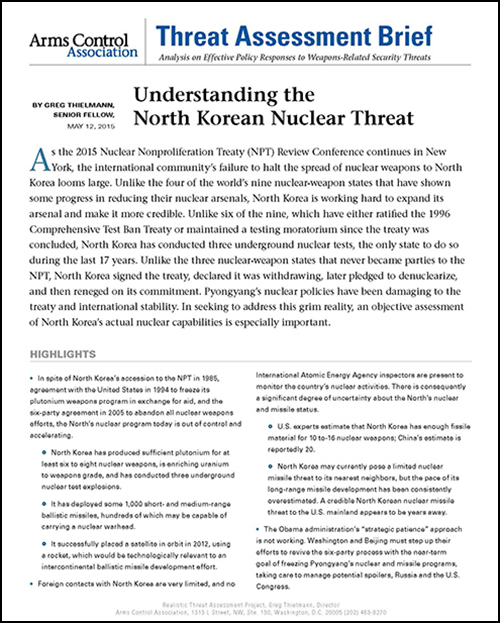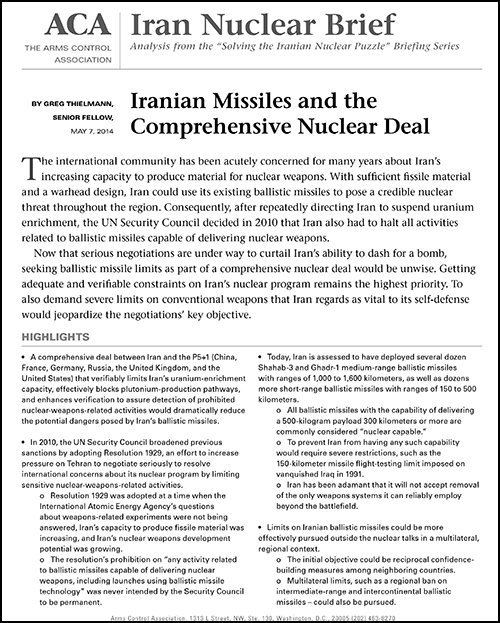Volume 5, Issue 5, March 20, 2014
As President Vladimir Putin exploits the results of Crimea's illegitimate referendum and as Russian troops gather on Ukraine's eastern border, alarms have been raised in the West that U.S.-Russian relations are on the verge of plummeting to Cold War levels.
American politicians and pundits have presented an array of policy response options, including intensified NATO military activities in Russia's "near abroad" and retreat from cooperative endeavors in U.S.-Russian arms control. At such times, there is a critical need for prudence, rationality, and historical perspective, and for avoiding actions that are counterproductive to the interests of the United States and our European allies.
Russia's actions certainly require a strong response, including international condemnation and measured sanctions against key Russian figures. The fragile new government in Kiev also needs assistance to put the country's economy on a more stable footing and to help counter any Russian efforts to intimidate Ukraine or seize additional territory.
However, U.S. policymakers should recognize that despite the severe differences with President Putin over Ukraine, it is clearly in the national interests of the United States to
- scrupulously implement existing arms control treaty verification measures, which provide vital information and help to ensure compliance with treaty limits regarding Russian and U.S. military capabilities;
- reduce expenditures on nuclear weapons that have no marginal utility and continue to seek further reductions in the still oversized nuclear arsenals of Russia and the United States;
- refrain from using strategic weapons to make political gestures;
- redouble efforts to maintain dialogue between U.S. and Russian nongovernmental experts and organizations.
A Cold Peace, Not a New Cold War
It is also important to avoid facile comparisons with the four-decade-long, post-World War II confrontation between the United States and the Soviet Union. As Cold War veteran Jack Matlock, the U.S. Ambassador to Moscow during the Gorbachev era, recently observed, "The tensions between Russia and the West are [now] based more on misunderstandings, misrepresentations and posturing for domestic audiences than on any real clash of ideologies or national interests."
By the end of the second term of President George W. Bush, Russia's relationship with the United States and Western Europe was already troubled; Russia's war with Georgia in 2008 had cast a particular chill over a range of diplomatic undertakings. Although the Obama administration's "reset" in 2009 facilitated negotiation and ratification of the New Strategic Arms Reduction Treaty (New START), a new "Cold Peace" had settled over bilateral relations.
Today, Russia's behavior often appears to be driven by President Putin's interest in maintaining a strong grip on power inside Russia and to prevent more of the states of the former Soviet Union from integrating into the European economic and political sphere.
In contrast, the Cold War was a global struggle involving the near constant threat of a direct military confrontation and frequent proxy wars. Throughout much of the Cold War, more than 250,000 Soviet troops were positioned along the border of West Germany to seize isolated West Berlin and drive toward the English Channel. That border divided not only a nation, but two powerful military alliances, each possessing vast nuclear arsenals maintained on high alert and targeted against each other. At the time, many American politicians depicted a growing Soviet superiority--not only in conventional forces in Europe, but in continent-spanning strategic missiles and ballistic missile defense systems, which allegedly enabled Moscow to pose the threat of a disarming, first-strike attack on the United States.
The Cold War also demonstrated dramatically the extent of nuclear dangers in the ideologically driven confrontation between Moscow and Washington. Indeed, the world came far closer to a nuclear exchange in 1962 (during the Cuban Missile Crisis) and in 1983 (following the Soviet shootdown of the Korea Airlines passenger plane and during NATO's "Able Archer" military exercises) than was publicly known at the time.
The striking dissimilarity between the present and that earlier era is captured by comparing the Cold War Soviet Threat Assessments of the U.S. intelligence community with its 2014 Worldwide Threat Assessment, whose 27-page public summary did not even mention Russia's nuclear arsenal.
At the same time, there are two elements of conspicuous continuity between the past and present.
First, Washington and Moscow still possess huge nuclear arsenals, far larger than those of all other nuclear weapons states combined. These arsenals contain thousands of warheads--each one of which dwarfs the destructive power of those that leveled Hiroshima and Nagasaki--far more than are needed for any rational requirement of nuclear deterrence and beyond any possible utility for political leverage in the current crisis over Ukraine.
Second, as was the case during the Cold War, reducing nuclear dangers rightly trumps other issues. During the lowest points of the U.S.-Soviet relationship, arms control agreements helped prevent a complete collapse of bilateral communication. The Limited Nuclear Test Ban Treaty survived the Vietnam War and crises in the Middle East; the Anti-Ballistic Missile Treaty survived the 1981 declaration of martial law in Poland and the 1979 Soviet Invasion of Afghanistan.
The conflicting interests of the United States and Russia in Ukraine or Syria today do not erase their joint interests in reducing the risks of nuclear weapons accidents or unauthorized nuclear weapons use, curbing the spread of nuclear weapons, securing vulnerable nuclear weapons usable material to avoid terrorist acquisition, and reducing their own costly nuclear arsenals, which still vastly exceed common-sense deterrence requirements. These and other common concerns make it imperative that Washington and Moscow continue pursuing efforts to achieve reductions in and limitations on nuclear weapons - independent of the health of the bilateral relationship at a particular point in time.
Russia's provocative actions in Crimea and the deterioration in U.S.-Russian relations certainly make the pursuit of a cooperative agenda even more challenging and there is more than a theoretical danger of backsliding. Yet, even in the darkest days of the Cold War, the United States and the Soviet Union shared a common interest in reducing nuclear risks and found ways to overcome ideological differences to pursue joint initiatives and agreements designed to reduce those risks and strengthen strategic stability.
The rapidly evolving situation in Ukraine makes it difficult to offer a detailed formula for preserving and promoting advantageous U.S.-Russian arms control and nuclear security outcomes, but some general principles can be outlined:
Continue to scrupulously implement existing treaty verification measures. No matter what their differences on the Ukraine crisis, it is not in the interest of either the United States or Russia to suspend inspections required by New START or to otherwise walk away from a treaty, which establishes clear, verifiable limits on each side's strategic nuclear arsenal--a measure of stability in an otherwise strained bilateral relationship. Weakening the implementation of verification measures would simply reduce the confidence levels of national threat assessments, leading to higher "worst case" projections and increased strategic spending.
Furthermore, according to Part Five, Section IX of the Protocol of the New START Treaty, the only basis for the cancellation of inspections are "circumstances brought about by force majeure," which do not apply to political differences over events in Ukraine.
Continue to reduce expenditures on nuclear weapons that have no marginal utility. Even at a time of heightened U.S.-Russian tensions, Washington can and should reduce spending for those nuclear weapons that have no utility as instruments of power in dealing with political crises like Ukraine. The new Quadrennial Defense Review says that the United States can cut strategic warheads by one-third below New START and still provide more than sufficient nuclear firepower to deter nuclear attack. Now is the time to avoid squandering tens of billions of dollars on nuclear weapons projects that the United States does not need and cannot afford.
Refrain from using strategic weapons to make aggressive political gestures. U.S. tactical nuclear weapons in Europe are not militarily useful for the defense of NATO allies. Some have recently suggested that such weapons should be deployed further east into the newer NATO members bordering on Russia. However, such action would be politically divisive inside the NATO Alliance and would likely provoke dangerous responses by Moscow.
Some have suggested accelerating the ongoing deployment of U.S. missile defenses to Europe under the European Phased Adaptive Approach (EPAA), reviving the "third-site" deployment of strategic missile interceptors to Poland, or deploying missile defense cruisers to the Baltic and Black Seas. Such moves would be extremely counterproductive, since they would seem to validate Russian suspicions that U.S. missile defenses in Europe have either been oriented against them all along, or at least would provide the infrastructure for rapidly adding a capability to threaten Russia's strategic deterrent.
Moreover, as the U.S. Government has continually insisted, none of the specific U.S. missile defense systems considered for deployment in Europe would be capable of defending Europe (or the United States) from Russian strategic forces. NATO should therefore maintain its steady course in implementing the first three phases of the EPAA, which do not include defenses against ICBMs, in response to evolving missile threats from the Middle East. Moreover, NATO should articulate more clearly its readiness to adapt downward its EPAA deployments if no Iranian IRBM/ICBM threat materializes.
Redouble efforts to maintain "Track 2" dialogue between American and Russian interlocutors. At a time of strained relations between the U.S. and Russian governments, it is even more important to use unofficial channels of communication to better understand the differing national perspectives and to search for policy options that would constitute acceptable compromises by both sides. One such ongoing effort is the German/Russian/U.S. Commission on "Challenges to Deep Cuts in Nuclear Arms," www.deepcuts.org, which is scheduled to release an interim report in late April.
Above all, the United States and Russia need to maintain a realistic perspective about the limits of hostility imposed by the existence of each other's nuclear weapons and an active appreciation of the mutual benefits they are now enjoying from cooperative endeavors - such as the generation of electricity in the United States from Russian-supplied fissile material and the security provided by a northern route of supply (through Russia) for NATO forces in Afghanistan.
When the current tensions subside, there will be other cooperative opportunities to exploit in the bilateral relationship and none will be more important for the world than finding the elusive path to mutual reductions in Cold War-sized U.S. and Russian nuclear arsenals.--GREG THIELMANN
###
The Arms Control Association (ACA) is an independent, membership-based organization dedicated to providing information and practical policy solutions to address the dangers posed by the world's most dangerous weapons. ACA publishes the monthly journal, Arms Control Today.








